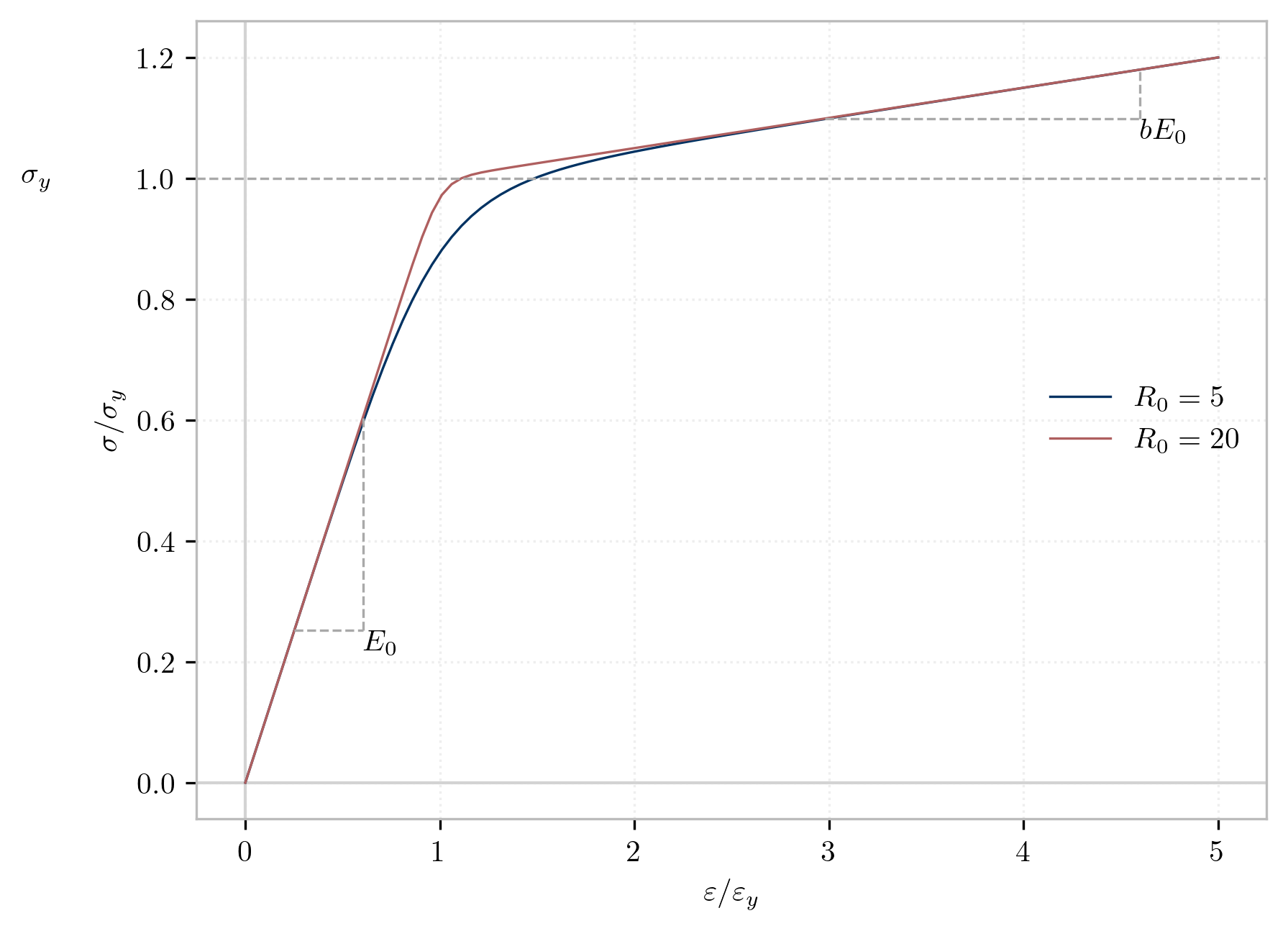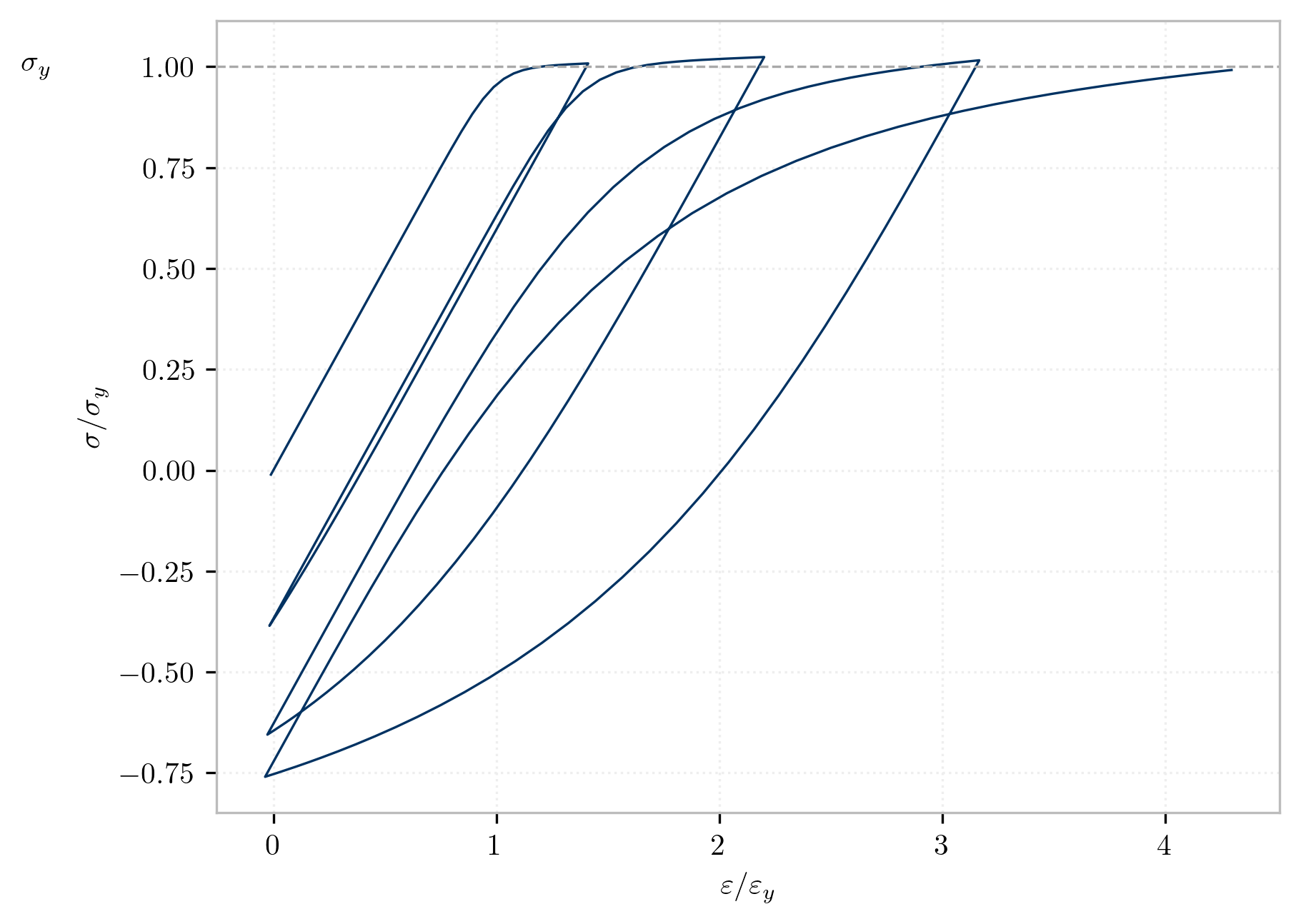Steel02#
Steel02 is a uniaxial material based on the Giuffre-Menegotto-Pinto formulation with added isotropic strain hardening by [FilippouEtAl1983].
- Model.uniaxialMaterial("Steel02", tag, Fy, E, b, R0, cR1, cR2[, a1, a2, a3, a4, sigInit])
Add a Steel02 material to model identified by tag.
- Parameters:
tag (int) – integer tag identifying material
Fy (float) – yield stress, \(F_y\) [1]
E (float) – initial elastic tangent, \(E\) [1]
b (float) – strain-hardening ratio, \(b\)
R0 (float) – parameter to control the transition from elastic to plastic branches, \(R_0\)
cR1 (float) – parameter to control the transition from elastic to plastic branches, \(cR1\)
cR2 (float) – parameter to control the transition from elastic to plastic branches, \(cR2\)
a1 (float) – isotropic hardening parameter (optional: default = 0.0).
a2 (float) – isotropic hardening parameter (optional: default = 1.0).
a3 (float) – isotropic hardening parameter (optional: default = 0.0).
a4 (float) – isotropic hardening parameter (optional: default = 1.0).
sigInit (float) – Initial Stress Value (optional: default = 0.0)
- uniaxialMaterial Steel02 $tag $Fy $E $b $R0 $cR1 $cR2 <$a1 $a2 $a3 $a4 $sigInit>
Argument |
Type |
Description |
|---|---|---|
tag |
integer |
integer tag identifying material |
Fy |
float |
yield strength |
E |
float |
initial elastic tangent |
b |
float |
strain-hardening ratio (ratio between post-yield tangent and initial elastic tangent) |
R0 CR1 CR2 |
3 float |
parameters to control the transition from elastic to plastic branches. |
a1 |
float |
isotropic hardening parameter. (optional: default = 0.0). see note. |
a2 |
float |
isotropic hardening parameter (optional: default = 1.0). see note. |
a3 |
float |
isotropic hardening parameter. (optional: default = 0.0). see note. |
a4 |
float |
isotropic hardening parameter. (optional: default = 1.0). see note. |
sigInit |
float |
Initial Stress Value (optional: default = 0.0) |
Formulation#
The hardening formulation was developed by [FilippouEtAl1983].
The parameters a1 and a2 increase of compression yield envelope as proportion of yield strength after a plastic strain of \(a_2 F_y/E\).
The parameters a3 and a4 increase of tension yield envelope as proportion of yield strength after a plastic strain of \(a_4 F_y/E\).
Typical values are R0 between 10 and 20, cR1=0.925, cR2=0.15

Steel02 monotonic envelope#

Hysteretic behavior without isotropic hardening#
cite{goldberg1963analysis} proposed a curve which furnishes the stress explicitly in terms of strain, as expressed below:
where \(\bar{\sigma}=\sigma/F_y\), \(\bar{\varepsilon}=\varepsilon/\varepsilon_y\), \((F_y, \varepsilon_y)\) is the yield point, \(b\) is the strain hardening parameter, and the parameter \(r\) influences the shape of the transition curve and takes account of the Bauschinger effect. A hysteretic loading-reloading algorithm for this curve was proposed by cite{giuffre1970comportamento}, which was extended by cite{filippou1983effects} to include isotropic hardening.
Example#
The following example defines a Steel02 material with tag 1, a yield stress of 60.0 and an initial tangent stiffness of 30000.
model.uniaxialMaterial('Steel02',1, 60.0, 30000.0, 0.1, 20.0, .925, .15)
uniaxialMaterial Steel02 1 60.0 30000.0 0.1 20.0 .925 .15
References#
Code Developed by: Michael H. Scott, fcf